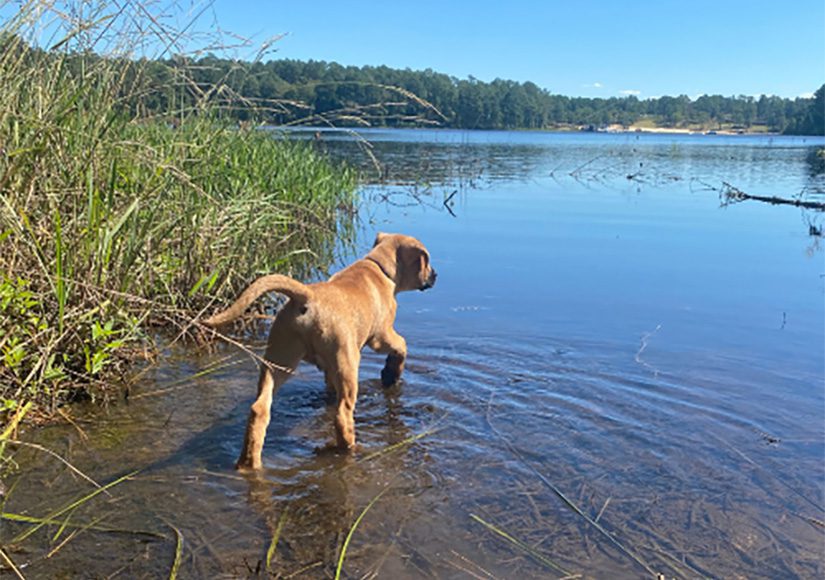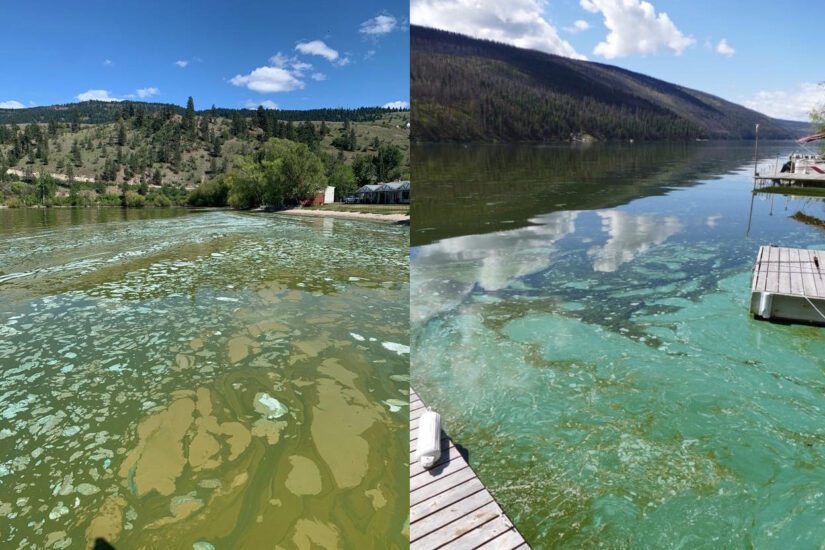Everyone loves watching their dog run and jump off a dock into a lake or splashing around in a river after a hike, having fun. What harm could come from that?

Well, depending on the conditions, a dip in the lake or river, could be deadly for your dog. Why? Blue-green algae (cyanobacteria) poisoning, also known as cyanobacterial toxicosis. This occurs when dogs drink or swim in water contaminated by an algal bloom where cyanotoxins are present and can lead to skin, liver or neurologic damage depending on the specific cyanotoxin. March is pet poison awareness month, and although we will focus on the potential harm to dogs, cyanobacteria toxins can have mild to life-threatening effects on people and other animals including horses, cattle, deer, sheep and birds.
Blue-green algae (cyanobacteria) are microscopic organisms that grow naturally in freshwater ecosystems, (eg. rivers, streams, lakes and marshes) across B.C. They are invisible to the naked eye and when in low numbers, don’t normally pose any kind of danger. But when optimal conditions are present, algae numbers increase rapidly or “bloom” and present a real risk to you and your dog.
What to look for?
Blue-green algae (cyanobacteria) blooms range in colour from dark green to red and yellowish-brown and create a sheen on the surface of the water like spilled paint; there may also be scum, foam or globs of algae. It is important to note that not all blue-green algae (cyanobacteria) create toxins, but it is impossible to determine that fact by looking at the bloom, so it is better to be cautious and assume all blue-green algae (cyanobacteria) blooms are toxic and to stay away from the water if you see one.


What to do?
If you think your pet may have been exposed to an algal bloom, rinse their fur with fresh water and contact your veterinarian or a veterinary hospital immediately. The veterinarian may advise an examination, or to monitor for signs of toxicity depending on the specific situation.
Signs of cyanobacterial toxicosis
Signs of cyanobacterial toxicosis in dogs may include any of the following and will vary depending on the toxins in the water. These signs may develop rapidly or over several hours.
- vomiting
- diarrhea
- weakness
- pale gums
- collapse
- drooling
- muscle tremors
- difficulty breathing
- muscle rigidity
- paralysis
- seizures
- sudden death
The effects of exposure to cyanotoxins have the potential to be rapidly fatal and, in some cases, death can take place within 15 minutes of exposure. The good news is that this can be prevented by taking a few easy steps.
- Be aware of local risks – certain freshwater ecosystems are more likely to be a risk than others. Check local advisories for warnings.
- Know the signs of blue green algae (cyanobacteria) blooms and assume toxins are present.
- Don’t let your dog into any water that looks remotely suspicious.
- Talk to your vet. They may know cases where this kind of poisoning has occurred and which areas you should avoid.
If you see an algae bloom in drinking or recreational water, contact local health authorities.
For more information on blue-green algae (cyanobacteria) blooms in B.C. visit the Government of B.C.’s Algae Watch program.
